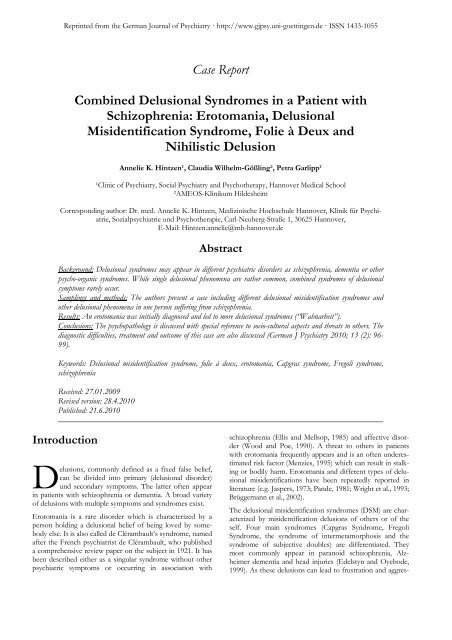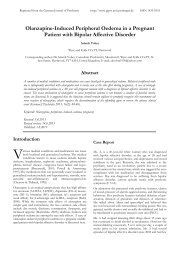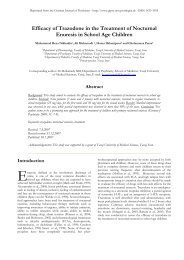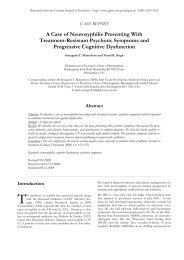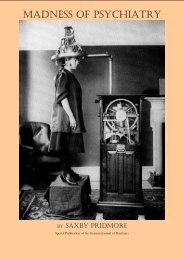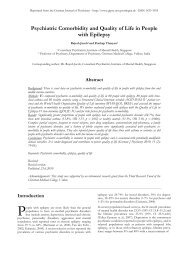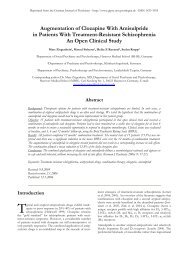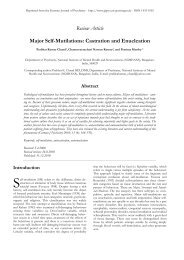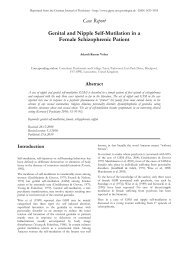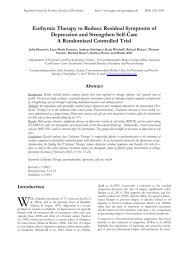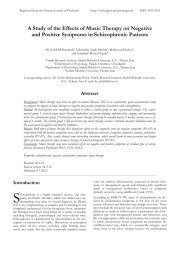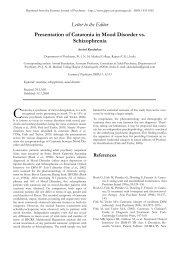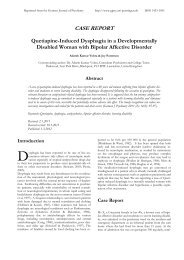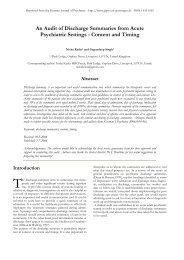Combined Delusional Syndromes in a Patient with Schizophrenia
Combined Delusional Syndromes in a Patient with Schizophrenia
Combined Delusional Syndromes in a Patient with Schizophrenia
Create successful ePaper yourself
Turn your PDF publications into a flip-book with our unique Google optimized e-Paper software.
Repr<strong>in</strong>ted from the German Journal of Psychiatry · http://www.gjpsy.uni-goett<strong>in</strong>gen.de · ISSN 1433-1055<br />
Case Report<br />
<strong>Comb<strong>in</strong>ed</strong> <strong>Delusional</strong> <strong>Syndromes</strong> <strong>in</strong> a <strong>Patient</strong> <strong>with</strong><br />
<strong>Schizophrenia</strong>: Erotomania, <strong>Delusional</strong><br />
Misidentification Syndrome, Folie à Deux and<br />
Nihilistic Delusion<br />
Annelie K. H<strong>in</strong>tzen¹, Claudia Wilhelm-Gößl<strong>in</strong>g², Petra Garlipp¹<br />
¹Cl<strong>in</strong>ic of Psychiatry, Social Psychiatry and Psychotherapy, Hannover Medical School<br />
²AMEOS-Kl<strong>in</strong>ikum Hildesheim<br />
Correspond<strong>in</strong>g author: Dr. med. Annelie K. H<strong>in</strong>tzen, Mediz<strong>in</strong>ische Hochschule Hannover, Kl<strong>in</strong>ik für Psychiatrie,<br />
Sozialpsychiatrie und Psychotherapie, Carl-Neuberg-Straße 1, 30625 Hannover,<br />
E-Mail: H<strong>in</strong>tzen.annelie@mh-hannover.de<br />
Abstract<br />
Background: <strong>Delusional</strong> syndromes may appear <strong>in</strong> different psychiatric disorders as schizophrenia, dementia or other<br />
psycho-organic syndromes. While s<strong>in</strong>gle delusional phenomena are rather common, comb<strong>in</strong>ed syndromes of delusional<br />
symptoms rarely occur.<br />
Sampl<strong>in</strong>gs and methods: The authors present a case <strong>in</strong>clud<strong>in</strong>g different delusional misidentification syndromes and<br />
other delusional phenomena <strong>in</strong> one person suffer<strong>in</strong>g from schizophrenia.<br />
Results: An erotomania was <strong>in</strong>itially diagnosed and led to more delusional syndromes (“Wahnarbeit”).<br />
Conclusions: The psychopathology is discussed <strong>with</strong> special reference to socio-cultural aspects and threats to others. The<br />
diagnostic difficulties, treatment and outcome of this case are also discussed (German J Psychiatry 2010; 13 (2): 96-<br />
99).<br />
Keywords: <strong>Delusional</strong> misidentification syndrome, folie à deux, erotomania, Capgras syndrome, Fregoli syndrome,<br />
schizophrenia<br />
Received: 27.01.2009<br />
Revised version: 28.4.2010<br />
Published: 21.6.2010<br />
Introduction<br />
D<br />
elusions, commonly def<strong>in</strong>ed as a fixed false belief,<br />
can be divided <strong>in</strong>to primary (delusional disorder)<br />
und secondary symptoms. The latter often appear<br />
<strong>in</strong> patients <strong>with</strong> schizophrenia or dementia. A broad variety<br />
of delusions <strong>with</strong> multiple symptoms and syndromes exist.<br />
Erotomania is a rare disorder which is characterized by a<br />
person hold<strong>in</strong>g a delusional belief of be<strong>in</strong>g loved by somebody<br />
else. It is also called de Clérambault’s syndrome, named<br />
after the French psychiatrist de Clérambault, who published<br />
a comprehensive review paper on the subject <strong>in</strong> 1921. It has<br />
been described either as a s<strong>in</strong>gular syndrome <strong>with</strong>out other<br />
psychiatric symptoms or occurr<strong>in</strong>g <strong>in</strong> association <strong>with</strong><br />
schizophrenia (Ellis and Mellsop, 1985) and affective disorder<br />
(Wood and Poe, 1990). A threat to others <strong>in</strong> patients<br />
<strong>with</strong> erotomania frequently appears and is an often underestimated<br />
risk factor (Menzies, 1995) which can result <strong>in</strong> stalk<strong>in</strong>g<br />
or bodily harm. Erotomania and different types of delusional<br />
misidentifications have been repeatedly reported <strong>in</strong><br />
literature (e.g. Jaspers, 1973; Pande, 1981; Wright et al., 1993;<br />
Brüggemann et al., 2002).<br />
The delusional misidentification syndromes (DSM) are characterized<br />
by misidentification delusions of others or of the<br />
self. Four ma<strong>in</strong> syndromes (Capgras Syndrome, Fregoli<br />
Syndrome, the syndrome of <strong>in</strong>termetamorphosis and the<br />
syndrome of subjective doubles) are differentiated. They<br />
most commonly appear <strong>in</strong> paranoid schizophrenia, Alzheimer<br />
dementia and head <strong>in</strong>juries (Edelstyn and Oyebode,<br />
1999). As these delusions can lead to frustration and aggres-
EROTOMANIA<br />
sive ideas or behaviour (also shown <strong>in</strong> this case report), this<br />
phenomenon is important to be recognized (Aziz et al.,<br />
2005). In Capgras syndrome, an <strong>in</strong>dividual has the delusion<br />
that the psychological identity but not the physiological<br />
appearance of another, is significantly transformed (Capgras<br />
and Reboul-Lachaux, 1923; Silva et al., 1990). In Fregoli<br />
syndrome the affected person believes that others can assume<br />
different physical identities while reta<strong>in</strong><strong>in</strong>g their psychological<br />
identity (Courbon and Fail, 1927; Silva et al.,<br />
1990). Intermetamorphosis is characterized by the patient’s<br />
conviction that a person has changed both physically and<br />
psychologically. The syndrome of subjective doubles is the<br />
delusional belief that a stranger has been altered <strong>in</strong>to the<br />
patient’s own self.<br />
The <strong>in</strong>duced delusional disorder (DSM-IV: “shared paranoid<br />
disorder”), also known as folie à deux, is a psychiatric condition<br />
characterized by the presence of similar psychotic symptoms<br />
<strong>in</strong> two or more persons. Characteristically one person<br />
suffers from a psychosis and the other, primarily a nonpsychotic<br />
person is affected by the delusional content. Folie<br />
simultanée describes two people <strong>in</strong>dependently suffer<strong>in</strong>g from<br />
a psychosis who <strong>in</strong>fluence the content of each other’s delusions<br />
that becomes similar as a consequence. The occurrence<br />
of <strong>in</strong>duced delusional disorder is a fairly uncommon disturbance<br />
and usually members of the same family or persons<br />
closely related <strong>in</strong> another way are <strong>in</strong>volved (Wehmeier et al.,<br />
2003).<br />
The nihilistic delusion, also called Cotard’s syndrome, is a<br />
psychopathological condition that ma<strong>in</strong>ly occurs <strong>in</strong> depressive<br />
disorders. It entails nihilistic delusions concern<strong>in</strong>g the<br />
body and the nonexistence of the self as outstand<strong>in</strong>g features,<br />
accompanied by hypochondriacal delusions as well as<br />
immortality (Berrios and Luque, 1995).<br />
There are reports of comb<strong>in</strong>ations of some of these syndromes<br />
occurr<strong>in</strong>g together (Enoch and Trethowan, 1991;<br />
Wolff and McKenzie, 1994; Han<strong>in</strong> et al., 1994; Margariti and<br />
Kontaxakis, 2006).<br />
The case presented below illustrates the co-occurrence of<br />
several delusional syndromes. To our knowledge there are<br />
no other reports of all these syndromes appear<strong>in</strong>g <strong>in</strong> one<br />
person.<br />
Case Report<br />
A 22-year-old male German-speak<strong>in</strong>g student of Hungarian<br />
orig<strong>in</strong> was <strong>in</strong>voluntarily admitted to the psychiatric hospital<br />
after he had misidentified a neighbour’s daughter as the one<br />
he was conv<strong>in</strong>ced of hav<strong>in</strong>g loved him for a long time.<br />
Ten months earlier the patient had come from Hungary to<br />
Germany <strong>in</strong> order to look for a 17-year old fair-haired and<br />
blue-eyed girl, whom he had met some weeks before <strong>in</strong> his<br />
home town at a Young Christians’ meet<strong>in</strong>g. He imag<strong>in</strong>ed her<br />
be<strong>in</strong>g <strong>in</strong> love <strong>with</strong> him after they talked for a little while.<br />
Afterwards he wanted to search for her and marry her.<br />
Know<strong>in</strong>g her name, her hometown and her school, he travelled<br />
to Germany <strong>in</strong> search of her <strong>with</strong> no success after<br />
several months. He loitered about for days at the alleged<br />
school, tried to get <strong>in</strong>formation about the girl and searched<br />
the neighbourhood. Some days before hospitalization, he<br />
was conv<strong>in</strong>ced the neighbour’s daughter was the one he was<br />
look<strong>in</strong>g for. He harassed this family, observed their house<br />
and f<strong>in</strong>ally tried to bully his way <strong>in</strong>to the house by threaten<strong>in</strong>g<br />
her father caus<strong>in</strong>g them to call the police. At that time he<br />
had the delusion that the girl was dead and her body was<br />
ly<strong>in</strong>g <strong>in</strong> the attic.<br />
On admission he was tense, suspicious and reported his<br />
<strong>in</strong>tense delusions. He felt that God controlled his thoughts<br />
and motor actions. He thought to be sane, that God would<br />
help him and that he did not need any medication. With<strong>in</strong><br />
the first week he walked around s<strong>in</strong>g<strong>in</strong>g Hungarian spiritual<br />
songs.<br />
At the age of 20 the patient was hospitalized <strong>in</strong> Hungary due<br />
to psychotic behaviour for the first time. There was no family<br />
history of psychotic disorders. Cl<strong>in</strong>ical exam<strong>in</strong>ation, <strong>in</strong>clud<strong>in</strong>g<br />
drug screen and syphilis serology were all normal.<br />
His condition met ICD-10 criteria for schizophrenia <strong>with</strong><br />
symptomatic delusional syndromes. It was not possible to<br />
perform a bra<strong>in</strong> computed tomography or magnetic resonance<br />
imag<strong>in</strong>g to exclude organic causes for these symptoms<br />
due to noncompliance, because the patient misjudged the<br />
Department of Neuroradiology as the place where the girl’s<br />
dead body was reta<strong>in</strong>ed.<br />
Risperidone was <strong>in</strong>itially trialled but <strong>with</strong>drawn due to a<br />
pronounced akathisia. Quetiap<strong>in</strong>e was used as an alternative.<br />
Despite quetiap<strong>in</strong>e be<strong>in</strong>g adm<strong>in</strong>istered at a rather high dosage<br />
(900 mg/d), comb<strong>in</strong>ed <strong>with</strong> carbamazep<strong>in</strong>e to reduce the<br />
impulsive aggression and diazepam for m<strong>in</strong>imiz<strong>in</strong>g anxiety,<br />
the delusional syndromes rema<strong>in</strong>ed unaffected.<br />
The patient’s ma<strong>in</strong> delusional topic was the loss of his identity.<br />
He claimed to be someone else, to come from somewhere<br />
else and to have another social orig<strong>in</strong>. For example he<br />
assumed that he had a German family <strong>in</strong>stead of his Hungarian<br />
background. One day he met a 20-year old female patient<br />
<strong>with</strong> a first episode of a schizoaffective disorder, who had<br />
the delusional idea to f<strong>in</strong>d a “brother”. As he was search<strong>in</strong>g<br />
for a “family” they bonded and he assumed her family name<br />
for the next days. They walked hand <strong>in</strong> hand tell<strong>in</strong>g everyone<br />
that they were sibl<strong>in</strong>gs. Frequently the patient demanded a<br />
DNA-analysis to verify his idea. The patient <strong>in</strong>sisted that his<br />
parents were not his parents anymore. He often became<br />
tense and angry when someone called him by his real name.<br />
After some weeks he perceived the girl’s dead body <strong>in</strong> the<br />
immediate vic<strong>in</strong>ity. He appeared to be agonised about this<br />
delusion and was look<strong>in</strong>g everywhere for the body. On the<br />
day of his discharge he himself believed he would die. He<br />
was told that his father would come to take him home (<strong>in</strong>deed<br />
he came from Hungary <strong>with</strong> some other family members<br />
to pick him up), but the patient thought God would<br />
take him to heaven.<br />
When his family arrived he <strong>in</strong>itially recognized them but<br />
ma<strong>in</strong>ta<strong>in</strong>ed that they had been replaced by physically identical<br />
persons. He was conv<strong>in</strong>ced that they had been replaced<br />
by doubles and thus he was uncerta<strong>in</strong> whether to jo<strong>in</strong> them.<br />
Due to these delusional misidentifications it was <strong>in</strong>itially not<br />
possible to conv<strong>in</strong>ce the patient to go back to Hungary.<br />
Only the costs the family had to pay due to his stay <strong>in</strong> a<br />
German hospital conv<strong>in</strong>ced him to f<strong>in</strong>ally jo<strong>in</strong> them.<br />
97
HINTZEN ET AL.<br />
Discussion<br />
Our patient meets all criteria for Erotomania (Ellis and<br />
Melssop, 1985). He had the delusional conviction of be<strong>in</strong>g<br />
loved by the German girl. The delusional belief occurred<br />
suddenly and took a chronic course for more than one year.<br />
As the delusion had its orig<strong>in</strong> <strong>in</strong> an underly<strong>in</strong>g mental disorder<br />
and occurred dur<strong>in</strong>g this disorder it is a secondary erotomania,<br />
which is most common (Mullen and Pathé, 1994).<br />
Accord<strong>in</strong>g to Goldste<strong>in</strong> and Lask<strong>in</strong> (2002) there is a potential<br />
risk for violent behaviour by erotomanic patients. In<br />
their forensic sample, 57 % of the patients were <strong>in</strong>volved <strong>in</strong><br />
violent situations (threat, persecution, rape, homicide). Most<br />
of them were male and many had a primary diagnosis of<br />
schizophrenia or a personality disorder. Another problem<br />
connected <strong>with</strong> erotomania is the manifestation of a chronic<br />
state.<br />
The patient suffered from multiple delusional misidentification<br />
syndromes: Misjudg<strong>in</strong>g the neighbour’s daughter for the<br />
girl <strong>in</strong> search for manifests a Fregoli Syndrome. The patient<br />
delusionally believed that the German girl could assume a<br />
different physical identity (neighbour’s daughter) while reta<strong>in</strong><strong>in</strong>g<br />
her psychological identity. Only few cases of a simultaneous<br />
appearance of Fregoli syndrome and erotomania<br />
(Collacott and Napier, 1991; Wright et al., 1993; Brüggemann<br />
and Garlipp, 2007) or Fregoli and Capgras <strong>Syndromes</strong><br />
(Papageorgiou et al., 2002; Lykouras et al., 2002) or a comb<strong>in</strong>ation<br />
of the three (Mann and Foreman, 1993) have been<br />
described. The Capgras syndrome <strong>in</strong> our patient was obvious<br />
when he misjudged his parents as be<strong>in</strong>g replaced by doubles.<br />
The <strong>in</strong>duced delusional disorder is a phenomenon ma<strong>in</strong>ly<br />
occurr<strong>in</strong>g <strong>in</strong> a family when one member has a genu<strong>in</strong>e psychotic<br />
disorder. In the present case two persons appear <strong>with</strong><br />
a similar delusion and they reciprocally aggravated their<br />
ideas. To our knowledge this symptom has not been reported<br />
<strong>in</strong> literature, we named it “reciprocal <strong>in</strong>duced delusion”,<br />
a type of folie simultanée.<br />
Some of the patient’s ma<strong>in</strong> delusional topics were death,<br />
dead persons or his own dy<strong>in</strong>g. This phenomenon is often<br />
described as nihilistic delusion or Cotard’s Syndrome. Current<br />
evidence regard<strong>in</strong>g Cotard’s Syndrome is based ma<strong>in</strong>ly<br />
on case studies and therefore no clarity can be obta<strong>in</strong>ed<br />
about the various aspects of this syndrome (Van den Eynde<br />
et al., 2008).<br />
The phenomenology and progression of the current case<br />
suggest that all these delusions may have a common orig<strong>in</strong><br />
and that a general conception <strong>in</strong> a fundamental identity<br />
change, possibly also triggered by the migrational background,<br />
is the most important def<strong>in</strong><strong>in</strong>g element of the course<br />
of these delusions (Silva and Leong, 1992). We assumed that<br />
the Erotomania was the orig<strong>in</strong>al delusion and all other delusions<br />
can be seen as consecutive delusions (“Wahnarbeit”).<br />
The patient came to Germany <strong>with</strong> the <strong>in</strong>tention to look for<br />
the girl he was conv<strong>in</strong>ced of lov<strong>in</strong>g him. After months of<br />
futile search he misjudged a neighbour’s daughter <strong>in</strong> the<br />
sense of a Fregoli syndrome. On the psychiatric ward he<br />
f<strong>in</strong>ally became completely <strong>in</strong>secure of his whole identity and<br />
developed a systematised delusion <strong>with</strong> folie simultanée, a<br />
Capgras syndrome and nihilistic delusion. These syndromes<br />
might also have been triggered by the foreign surround<strong>in</strong>gs<br />
the patient had to adjust to. Although his German was good,<br />
he was far away from his family and his cultural background.<br />
This fact might also enhance such pronounced pathology,<br />
although there are up to now no clear scientific results po<strong>in</strong>t<strong>in</strong>g<br />
<strong>in</strong> this direction (Assion, 2005).<br />
<strong>Delusional</strong> syndromes are often associated <strong>with</strong> organic<br />
bra<strong>in</strong> affections (Fricchione et al., 1995). As an EEG or<br />
cranial CT could not be realized due to non-compliance of<br />
the patient an exclusion of organic causes could not be fully<br />
made.<br />
Regard<strong>in</strong>g the treatment of delusional syndromes sufficient<br />
pharmacotherapy is essential (Segal, 1989). Antipsychotics,<br />
mood stabilizers and antidepressants were used to treat DMS<br />
<strong>with</strong> variable results (Silva et al., 1996). Our patient was<br />
treated <strong>with</strong> an antipsychotic, carbamazep<strong>in</strong>e and a benzodiazep<strong>in</strong>e.<br />
This comb<strong>in</strong>ation was successfully used <strong>in</strong> therapy<br />
of DMS (De Leon, 1992; Aziz et al., 2005). But probably due<br />
to a relative short observation period of six weeks our medication<br />
had no effect on the psychopathology <strong>in</strong> our patient.<br />
The primary aim of the therapy was the patient’s stabilisation<br />
by organis<strong>in</strong>g his return to Hungary. Thereby not only the<br />
cultural aspect as a disease trigger<strong>in</strong>g factor but also the<br />
factor of the threat to others, especially the neighbour’s<br />
daughter, was reduced.<br />
The danger to others is one of the ma<strong>in</strong> problems associated<br />
<strong>with</strong> delusional misidentification syndromes as well as erotomania.<br />
Although patients <strong>with</strong> dangerous delusional misidentifications<br />
were less likely to harm people than psychotic<br />
patients <strong>with</strong>out delusional misidentifications (Silva et al.,<br />
1995), our patient could not distance himself from stalk<strong>in</strong>g<br />
the girl and he had to be deta<strong>in</strong>ed <strong>in</strong> a closed psychiatric<br />
ward.<br />
To summarize this case report shows an extraord<strong>in</strong>ary comb<strong>in</strong>ation<br />
of different rare delusional syndromes and the<br />
therapeutic difficulties associated <strong>with</strong> them. The risk of<br />
becom<strong>in</strong>g a threat to others has to be assessed and an effective<br />
medication deal<strong>in</strong>g <strong>with</strong> the underly<strong>in</strong>g mental disorder<br />
should be established, e.g. a comb<strong>in</strong>ation of neuroleptics and<br />
mood stabilizers. Constant psychotherapeutical approaches<br />
may support the decrease of the symptomatology and other<br />
factors support<strong>in</strong>g the symptomatology – like <strong>in</strong> this case<br />
migrational aspects – should also be dealt <strong>with</strong>.<br />
Acknowledgment<br />
The authors gratefully acknowledge Dr. Stewart Jackson,<br />
Ingham, Australia, for read<strong>in</strong>g the article and giv<strong>in</strong>g helpful<br />
suggestions.<br />
References<br />
Assion, H-J. Migration und psychische Krankheit. In: Assion<br />
H-J. (ed.) Migration und seelische Gesundheit. Heidelberg:<br />
Spr<strong>in</strong>ger, 2005: 133-144<br />
Aziz MA, Razik GN, Donn JE. Dangerousness and management<br />
of delusional misidentification syndrome.<br />
Psychopathology 2005;38(2):97-102<br />
98
EROTOMANIA<br />
Berrios GE, Luque R. Cotard’s syndrome: analysis of 100<br />
cases. Acta Psychiatr Scand 1995;91(3):185-8<br />
Brüggemann BR, Werry C, Garlipp P, Pfefferer-Wolf H,<br />
Haltenhof H. Liebeswahn und Frégoli –Syndrom.<br />
E<strong>in</strong>e Kasuistik [Erotomania and Frégoli syndrome. A<br />
case report]. Nervenarzt 2002;73(5):475-7<br />
Brüggemann BR, Garlipp P. A special co<strong>in</strong>cidence of erotomania<br />
and Fregoli syndrome. Psychopathology 2007;<br />
40(6): 468<br />
Capgras J, Reboul-Lachaux J. L’ illusion des “sosies” dans un<br />
délire systematisé chronique. Bullet<strong>in</strong> de la Société<br />
Cl<strong>in</strong>ique de Médic<strong>in</strong>e Mentale 1923;11:6-16<br />
Courbon P, Fail G. Syndrome d’ illusion Frégoli et schizophrénie.<br />
Bullet<strong>in</strong> de la Société Cl<strong>in</strong>ique de Médic<strong>in</strong>e<br />
Mentale 1927;15:27-32<br />
Collacott RA, Napier EM. Erotomania and Fregoli-like state<br />
<strong>in</strong> Down’s syndrome: dynamic and developmental<br />
aspects. J Ment Defic Res 1991;35 ( Pt 5):481-6<br />
De León OA. The <strong>in</strong>termetamorphosis syndrome. J Cl<strong>in</strong><br />
Psychiatry 1992 Jan;53(1):29-30<br />
Edelstyn NM, Oyebode F. A review of the phenomenology<br />
and cognitive neuropsychological orig<strong>in</strong>s of the Capgras<br />
syndrome. Int J Geriatr Psychiatry 1999;14(1):<br />
48-59<br />
Ellis P, Mellsop G. De Clérambault’s syndrome--a nosological<br />
entity? Br J Psychiatry 1985;146:90-3<br />
Fricchione GL, Carbone L, Bennett WI: Psychotic disorder<br />
caused by a general medical condition, <strong>with</strong> delusions.<br />
Secondary "organic" delusional syndromes.<br />
Psychiatr Cl<strong>in</strong> North Am 1995;18:363-78<br />
Gillet T, Em<strong>in</strong>son SR, Hassanyeh F. Primary and secondary<br />
erotomania: cl<strong>in</strong>ical characteristics and follow-up. Acta<br />
Psychiatr Scand 1990;82(1):65-9<br />
Goldste<strong>in</strong> RL, Lask<strong>in</strong> AM. De Clerambault’s Syndrome<br />
(Erotomania) and claims of psychiatric malpractice. J<br />
Forensic Sci 2002;47(4):852-5<br />
Han<strong>in</strong> B, Perlow M, Ben-Daniel N, Itzhaki S. Reverse <strong>in</strong>termetamorphosis<br />
- a rare misidentification phenomenon.<br />
Isr J Psychiatry Relat Sci 1994;31(4):296-9<br />
Jaspers K. Allgeme<strong>in</strong>e Psychopathologie. 9. unveränderte<br />
Aufl. Spr<strong>in</strong>ger, Berl<strong>in</strong>, Heidelberg 1973<br />
Lykouras L, Typaldou M, Gournellis R, Vaslamatzis G,<br />
Christodoulou GN. Coexistence of Capgras and<br />
Frégoli syndromes <strong>in</strong> a s<strong>in</strong>gle patient. Cl<strong>in</strong>ical, neuroimag<strong>in</strong>g<br />
and neuropsychological f<strong>in</strong>d<strong>in</strong>gs. Eur Psychiatry<br />
2002;17(4):234-5<br />
Mann J, Foreman DM.Homo-erotomania for a delusional<br />
parent: erotomania <strong>with</strong> Capgras and Fregoli syndromes<br />
<strong>in</strong> a young male <strong>with</strong> learn<strong>in</strong>g difficulties. J<br />
Intellect Disabil Res 1996;40 ( Pt 3):275-8<br />
Margariti MM, Kontaxakis VP. Approach<strong>in</strong>g delusional<br />
misidentification syndromes as a disorder of the<br />
sense of uniqueness. Psychopathology 2006; 39(6):<br />
261-8<br />
Marková IS, Berrios GE. <strong>Delusional</strong> misidentifications: facts<br />
and fancies. Psychopathology 1994;27(3-5):136-43<br />
Menzies RP, Fedoroff JP, Green CM, Isaacson K. Prediction<br />
of dangerous behaviour <strong>in</strong> male erotomania. Br J<br />
Psychiatry 1995;166(4):529-36<br />
Mullen PE, Pathé M. The pathological extensions of love. Br<br />
J Psychiatry 1994;165(5):614-23<br />
Pande AC. Co-existence of <strong>in</strong>cubus and Capgras syndromes.<br />
Br J Psychiatry 1981;139:469-70<br />
Papageorgiou C, Lykouras L, Ventouras E, Uzunoglu N,<br />
Christodoulou GN. Abnormal P300 <strong>in</strong> a case of delusional<br />
misidentification <strong>with</strong> co<strong>in</strong>cid<strong>in</strong>g Capgras<br />
and Frégoli symptoms. Prog Neuropsychopharmacol<br />
Biol Psychiatry 2002;26(4):805-10<br />
Rentrop M, Theml T, Förstl H. Wahnhafte<br />
Missidentifikationen. Kl<strong>in</strong>ik, Vorkommen und neuropsychologische<br />
Modelle [<strong>Delusional</strong> misidentifications.<br />
Symptoms and neuropsychological models].<br />
Fortschr Neurol Psychiatr 2002;70(6):313-20<br />
Silva JA, Leong GB, Shaner AL. A classification system for<br />
misidentification syndromes. Psychopathology<br />
1990;23(1):27-32<br />
Silva JA, Leong GB. A case of Capgras-Fregoli syndrome. J<br />
Cl<strong>in</strong> Psychiatry 1992;53(2):67-8<br />
Silva JA, Leong GB, Miller AI. <strong>Delusional</strong> misidentification<br />
syndrome: Drug treatment options. CNS Drugs<br />
1996;5:89-102<br />
Segal JH. Erotomania revisited: from Kraepel<strong>in</strong> to DSM-III-<br />
R. Am J Psychiatry 1989;146(10):1261-6<br />
Van den Eynde F, Debruyne H, Portzky M, De Saedeleer S,<br />
Audenaert K. [The syndrome of Cotard: an overview]<br />
Tijdschr Psychiatr 2008;50(2):89-98<br />
Wehmeier PM, Barth N, Remschmidt H. Induced delusional<br />
disorder. a review of the concept and an unusual case<br />
of folie à famille. Psychopathology 2003;36(1):37-45<br />
Wolff G, McKenzie K. Capgras, Fregoli and Cotard’s syndromes<br />
and Koro <strong>in</strong> folie à deux. Br J Psychiatry<br />
1994;165(6):842<br />
Wood BE, Poe RO. Diagnosis and classification of erotomania.<br />
Am J Psychiatry 1990;147(10):1388-9<br />
Wright S, Young AW, Hellawell DJ. Frégoli delusion and<br />
erotomania. J Neurol Neurosurg Psychiatry<br />
1993;56(3):322-3<br />
The German Journal of Psychiatry · ISSN 1433-1055 · http:/www. gjpsy.uni-goett<strong>in</strong>gen.de<br />
Dept. of Psychiatry, The University of Gött<strong>in</strong>gen, von-Siebold-Str. 5, D-37075 Germany; tel. ++49-551-396607; fax:<br />
++49-551-398952; E-mail: gjpsy@gwdg.de<br />
99


